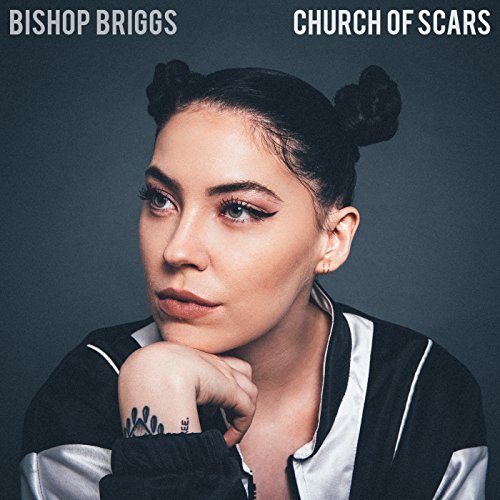
Church Of Scars (Bishop Briggs/Island Records)
Get ready to be glued to your earbuds for a full 33 minutes, because Bishop Briggs will make every second count. The British singer-songwriter released her debut album, Church of Scars, on April 20. The compilation is made up of 11 balanced and gut-wrenching tracks.
In the years building up to Church of Scars, Bishop Briggs moved to Los Angeles from England to pursue her music career at 18-years-old. It was not until 2016 when she started releasing songs such as “River” and “Wild Horses.” That year, “River” was listed amongst the top 10 best alternative and rock songs in that year’s music charts. In 2017, she put out her first EP Bishop Briggs. Songs included “Wild Horses,” “River” and four other singles.
With the release of this LP, Bishop Briggs proves to be the queen of ideal consistency. Throughout both Bishop Briggs and Church of Scars, she forms a unique blend composed of essences of alternative rock, folk and techno. However, there is an uncanny similarity between her songs. Adding to that notion, both “River” and “Wild Horses” were also included in Church of Scars.
More so than “River,” “Wild Horses” undoubtedly deserves to be present. The song starts off with the vocalist in a vulnerable tender tone on top of a twangy, simple guitar melody. An ear filling progression sweeps through the song as thumping drums build onto the sound. The drums guide the song into a heart-stopping beat drop that accompanies the chorus. Bishop Briggs sings the lyrics “Wild Horses” in between bursts of booming horns and dubstep. As the climax of the beat approaches, the tone rapidly changes back into the simple guitar melody signaling the beginning of the second verse. “Wild Horses” is engaging, catchy, dynamic and an absolute pleasure to listen to.
For an album labeled as indie-pop or alternative, Church of Scars holds killer beat drops. In the song “Hi-Lo” the chorus, like in “Wild Horses,” drops a gnarly beat that acts as a filler between Bishop Briggs singing “I’m so high low/high low.” The bass creates a wonderfully nasty vibration, buzzing earbuds to the peaks of its sound. The deep beat accompanied by the singer’s gritty yet powerful voice is nothing less than captivating.
A key feature in almost all of her new songs is the variety of tonal levels within each and every track. One of the most prominent examples is within the song “Hallowed Ground.” The introduction is made up of a low-key melody consisting of repeating piano chords and finger snaps. Briggs sings in a wispy voice which she interchanges with her signature vocal fry infused belt. As her voice builds up, the instruments do too. An organ pounds and leads the melody into a synthetic thunderstorm that could undoubtedly peak the interests EDM lovers. Throughout she keeps her versus more sedated and consistent with each other, bringing the song down to earth after each intense chorus.
Her infusion of folk and earthy sounds gives the music a huge dose of uniqueness. It is rare to find such tasteful music that contains elements of EDM and folk working in cadence with one another. In the song “White Flag,” rattling chains and a raw guitar sound feed off of one another until Bishop Briggs comes in. The utilization of natural sounds such as woody thuds and human claps adds an epic aura to the singer’s music. All of those gritty elements come to life during the chorus when they form an angry medley of different sounds. Briggs melodically yells the lyrics with her raspy yet beautiful voice. The roughness of her vocals joined together with the chaotic instrumentals offer up an fulfilling and intense experience.
Not all of the tracks on Church of Scars contain power surging choruses. Briggs sprinkled a few tender sob-story numbers within the album. The song “Water” does a great job pulling at the heartstrings. it starts off with a somber piano melody which continues to play softly throughout the verses. Briggs’ voice is what really sells the number. The toned down instruments help highlight her vulnerable yet engulfing lyrics. She also utilizes her falsetto skills to add softness and beauty to the melancholy love song. Even though the song does not contain traces of hype dubstep, it still fits the theme of interchanging power levels. The zenith of the song comes to life when a gospel chorus sings behind Briggs. The effect is wonderfully telling of the pain and desperation within the singer’s soul.
Despite being infatuated with Bishop Briggs’ talent, it is unsettling that she fails to stray away from her comfort zone. As mentioned before, her new music in relation to her older work has a little bit too much in common. Noticeably consistent elements can be detected within the instruments used such as steady hand claps, earthy and rigorous drums, and hollow sounding whistle tones. It would have been nice to see a little bit of growth from Bishop Briggs over the past few years but her comfort zone is one that is phenomenal to fall into. Her songs are soulful and deep, as well as dynamic and composed with great consideration and expertise. Hopefully, a lot more is yet to come from this fantastic new artist.
You can contact CU Independent arts writer Samantha Danshes at Samantha.Danshes@colorado.edu
